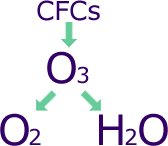|
Ozone
depletion is a quite different problem from global warming
or climate change.
In 1980, it was found that the ozone layer above the Antarctic
was thinner than ever before. It became known as "the hole"
in the ozone layer.
A thinner ozone layer meant that ultra violet raadiation could
get from the sun to earth more easily. This may damage people
and plants. UNEP figures indicate that a 1% decrease in world
ozone would increase skin cancers world-wide by 6%.
People in Australia and South America are particularly worried,
although people in the Northern Europe are now showing concerns.
Many developing countries do not consider it such a major
issue.
The
chemicals that cause climate change are generally different
from those that cause ozone depletion.
|
The
main 'ozone depleters' are Chlorofluorocarbons
which are very stable, easily evaporate and get up into the
stratosphere.

There
they attack the ozone, so letting the ultraviolet in. CFCs
are used in all sorts of places, in refrigerators, as solvents,
to propel materials from aerosol cans, and to create foams
for creams, and were thought to be "miracle" chemical
|


